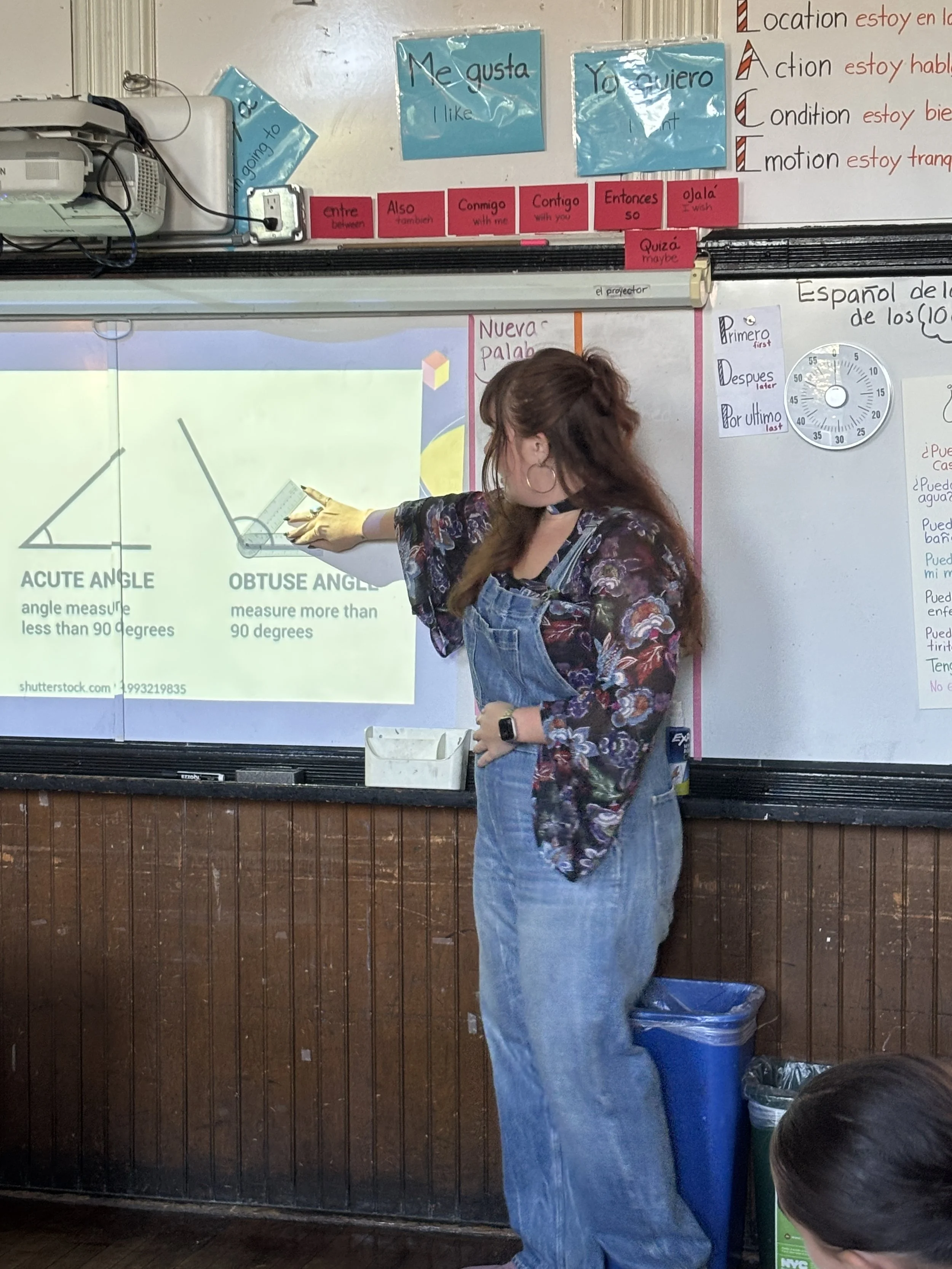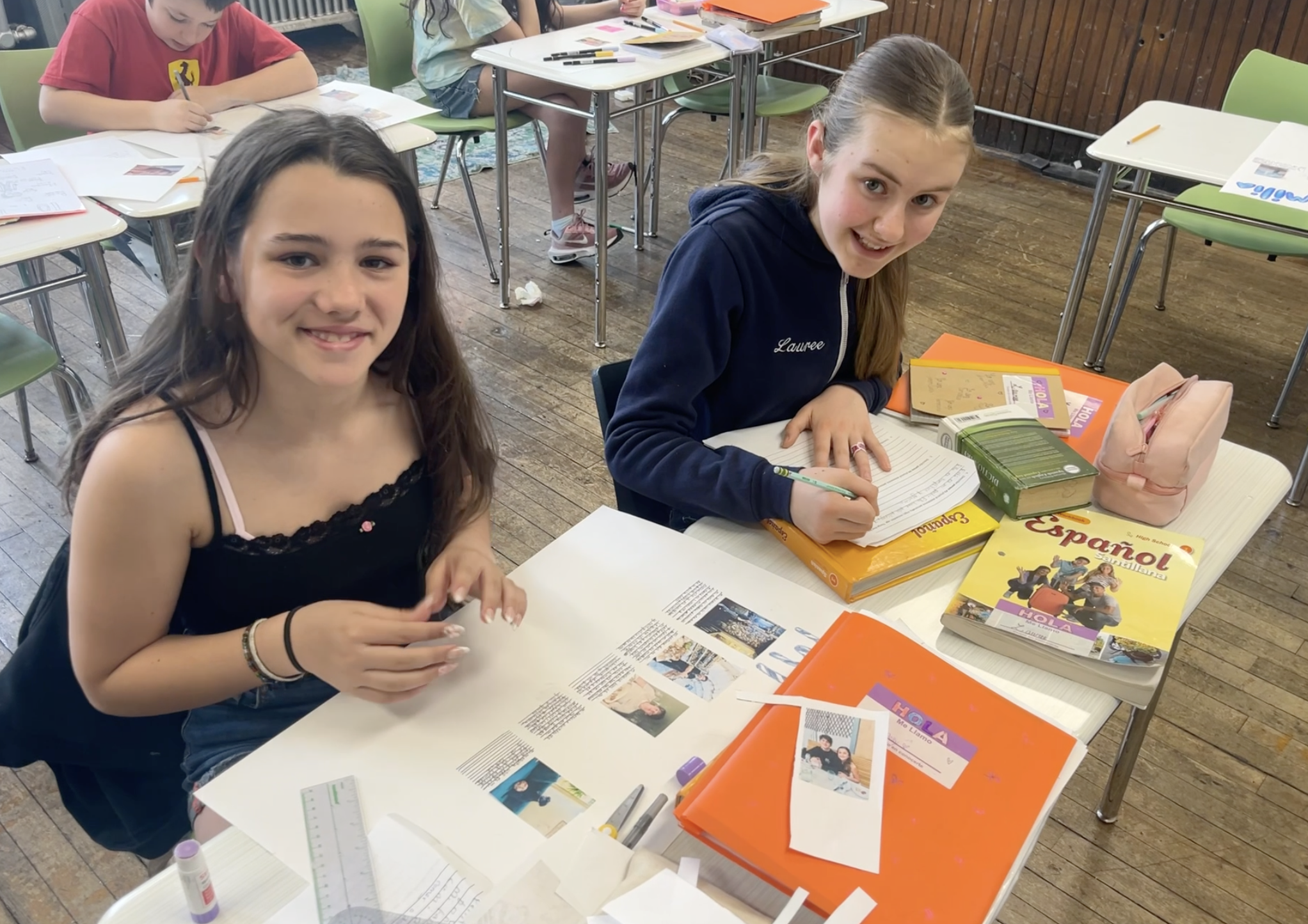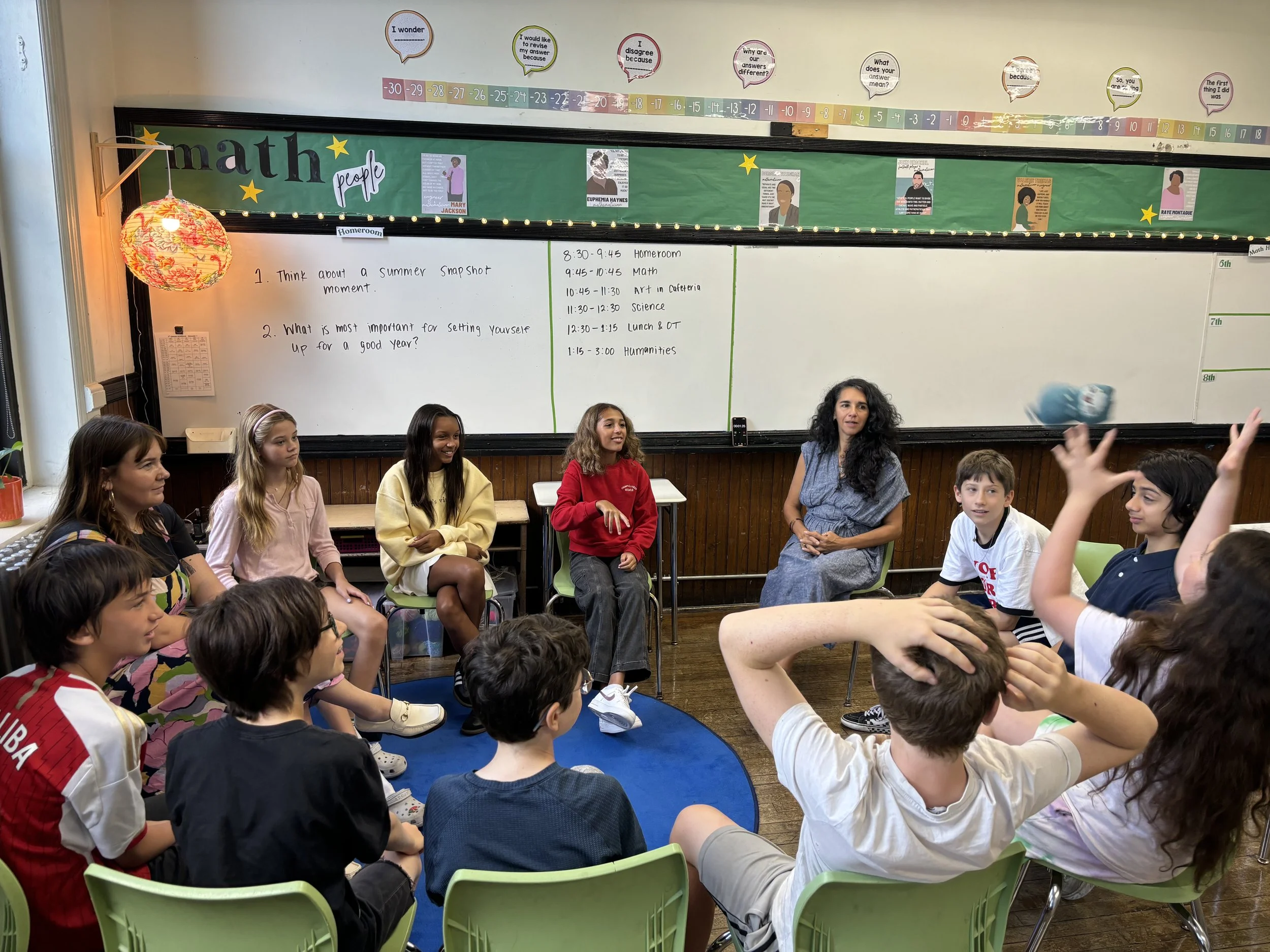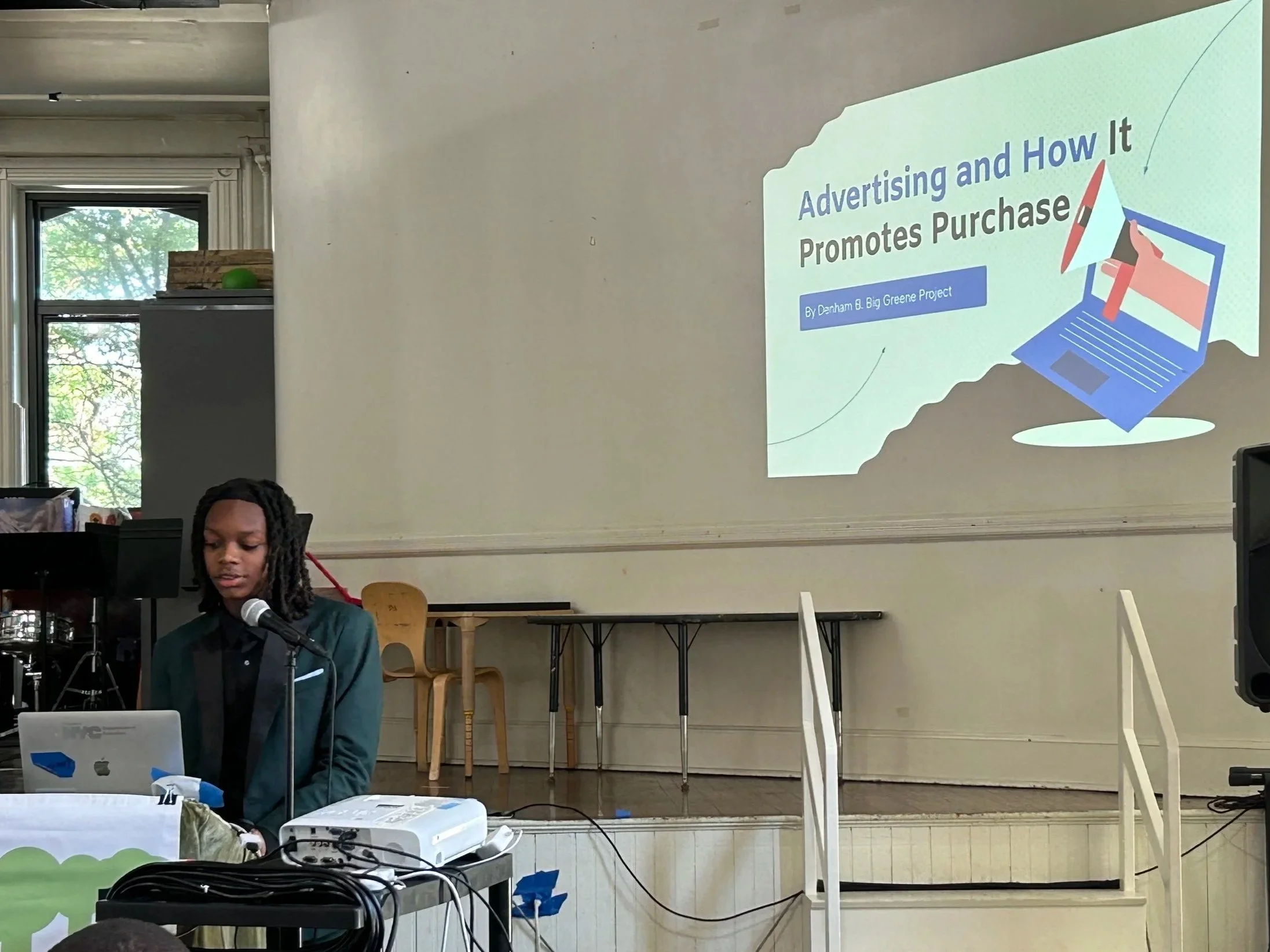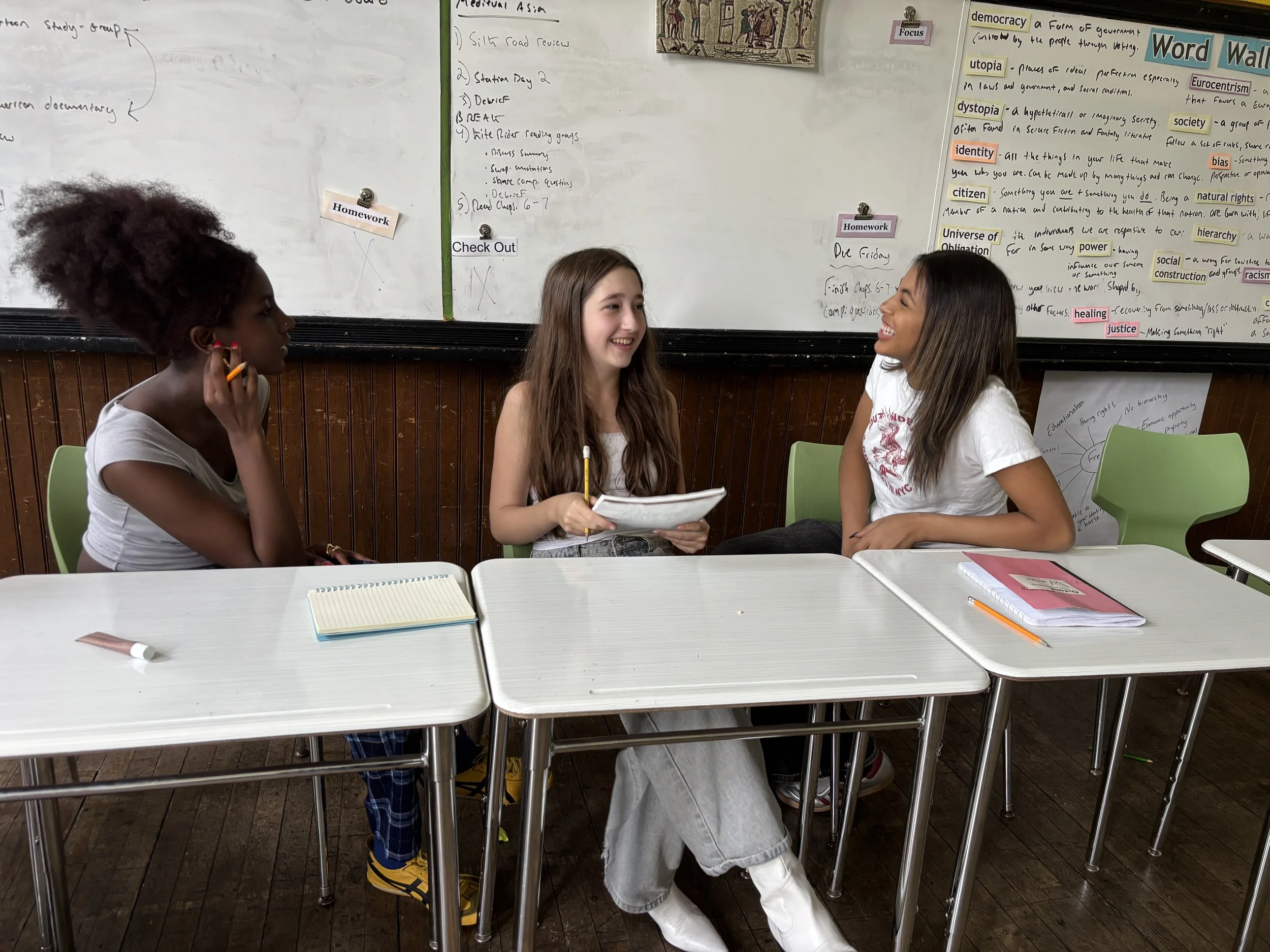Middle School
Greene Hill Middle School is dedicated to continuing the progressive approach to education that students experience in the lower grades. Our focus is on engaging children as active participants in and initiators of their own learning. Using a constructivist approach, students work to develop an understanding of a concept through investigation and experimentation. We encourage middle schoolers to investigate real-world problems and develop problem-solving and critical-thinking skills in the process.
6th - 8th Grade Curriculum
-

Supports the development of the traditional skills of critical reading, persuasive writing, analytical thinking, and research, within the context of learning about the past.
-

Students learn to analyze history from a critical lens, and look for the perspective of the other, marginalized groups whose stories are not told.
-

Middle schoolers to take ownership over all aspects of the writing process.
-
Allows students to build their knowledge of mathematics through exploration of real-world problems, engaging math activities, and opportunities to construct their own understandings of mathematical concepts.
-

Taking on authentic problems, students will interpret data and use evidence to support their scientific conclusions.
-

Our language program is geared toward increasing tools for interpersonal communication and fostering a global perspective.
-
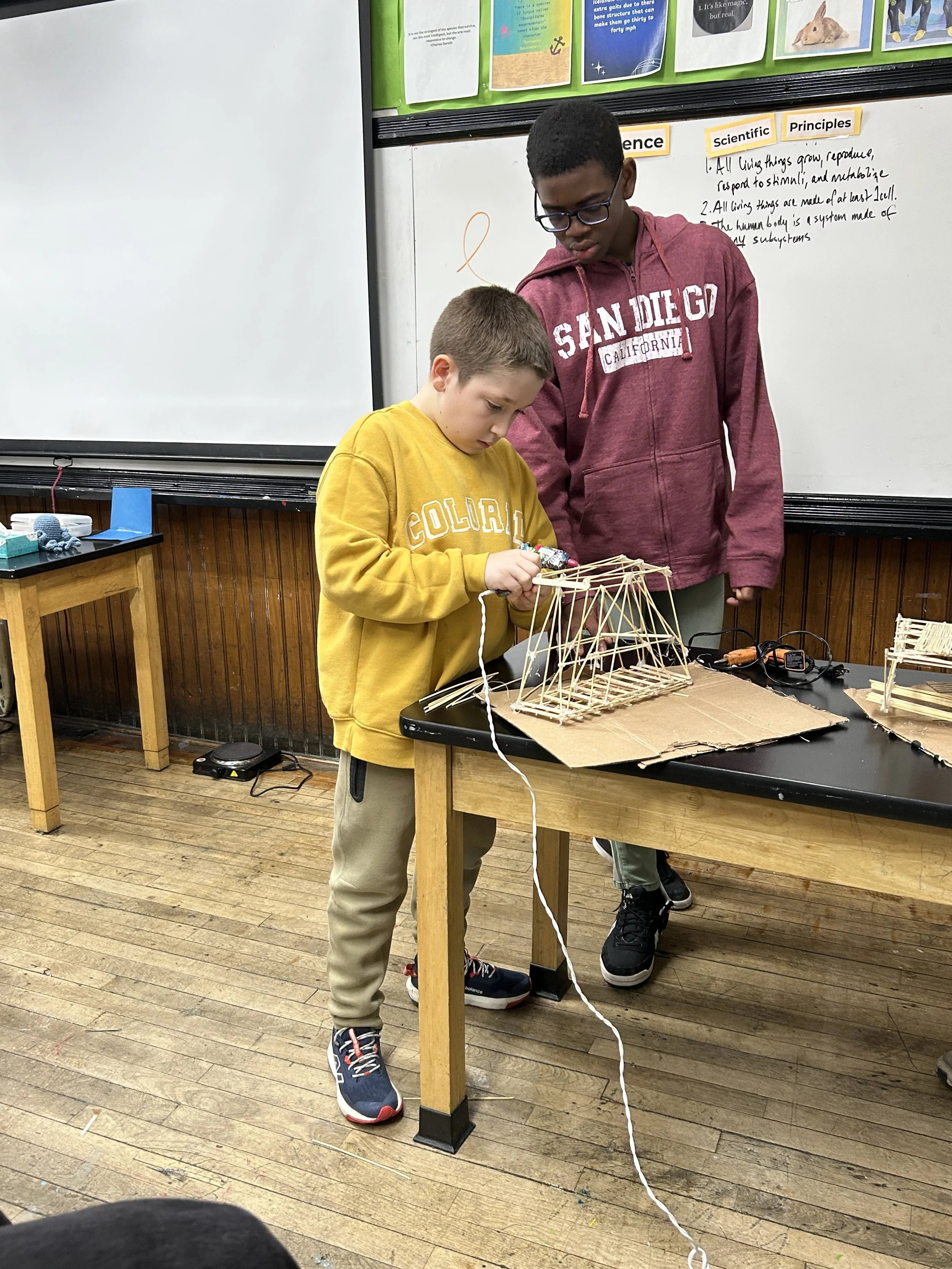
Middle school students have many opportunities to follow their interests and delve into independent projects across the curriculum.
-

Advisory, Independent Work, and Health and Wellness
-

Students graduating from Greene Hill are prepared to attend any of the broad range of excellent NYC high schools, both independent and public.
-

BIG GREENE PROJECT
As a culmination of their time in Middle School, eighth graders engage in a 12-week capstone project called the Big Greene Project (BGP)
Humanities
Our humanities curriculum supports the development of the traditional skills of critical reading, persuasive writing, analytical thinking, and research, within the context of learning about the past. These skills help students analyze situations through a historical lens. Humanities classes in the Middle School include content and skills from both literacy and history based on the premise that students become more engaged readers and more prolific writers if they are deeply immersed in their curricular content. History and social studies continue to be at the core of the curriculum as students engage in in-depth investigations of cultures from around the world. One goal of the Middle School humanities curriculum is to tie together contemporaneously occurring events around the world. In the Middle School, students study global and U.S. history through the lens of power and justice. Overarching questions include: Whose story is being told? How does conflict shape history? What are the roles and responsibilities of being a member of civil society? How has technology changed history? Course topics may change from year to year based on teacher and student interest.
Social Studies
-
Following upon the study of ancient civilizations in the 10s, sixth graders delve into the Middle Ages, learning about European, Middle Eastern, African, Asian, and North American civilizations from the 5th to 15th centuries. For 6th grade, a key theme of the year is perspective, which is investigated as students learn about world history around the year 1000 CE. 6th graders are encouraged to investigate the questions: How can I seek to understand another person’s perspective? Whose story is being told, who is telling it, and how could it be told in a different way? Studies focus on the function of class structure and social hierarchies and the role of religion. Classes look at ways in which aspects of modern society such as legal systems and mathematics stem from events and innovations that took place more than 1,000 years ago. By focusing on the theme of historical perspective and bias throughout the year, students learn to analyze history from a critical lens, and look for the perspective of the other, marginalized groups whose stories are not told. This critical inquiry fosters the growth of empathy and desire to create a more fair and just world.
-
Seventh graders explore the concepts of Utopia/Dystopia as they consider the founding of the United States. They read dystopian fiction and think about what it means to be a member of society. Students study the Colonial Era and the American Revolution, previously explored in the Lower School, with a deeper context for the colonists’ desire for independence and change at the same time analyzing parallels to dystopian literature. As part of this exploration of the past, students look into the origins of race and power and the lasting effects of hierarchical structure put in place in the 17th and 18th Centuries. Students analyze patterns in immigration throughout history and make connections both to access to power as well current events. Students deepen their abilities to track themes in literature, write analytically, and present their ideas publicly.
-
Eighth graders extend the study of American history by tracing the path from the Civil War to the Civil Rights Movement. This tumultuous period invites examination of issues of equality and justice, with attention to legal, military, social, and moral drivers of change. Complicated topics such as slavery, voting rights, marriage rights, privacy, and freedom of thought and speech are an important part of students’ exploration of this era. Students make connections between challenges Americans faced in the past and those they continue to contend with today. The eighth grade Humanities themes of citizenship, identity, and democracy incorporate an emphasis on activism, as students discuss oppression, multiculturalism, and what it means to be a social change maker. Teachers aim to inspire students to get involved in more activism outside of school by learning about different types of activist work and considering where their own passions may take them.
-
What are the roles, rights, and responsibilities of people in society?
What are the threads of continuity and change throughout history?
How do the beliefs and values of a diverse culture affect individuals and society?
What happens when cultures collide?
What impact does trade have on a culture?
Who has access to power?
How did major scientific, mathematical, and technological advances affect society?
What insights can historical narrative teach us about the current day?
-
Consider multiple perspectives.
Locate, interpret and integrate a wide variety of primary sources.
Analyze the interrelationships of a civilization’s components, e.g. government, religion, trade.
Ask probing questions about history that spark conversation.
Process information; take notes, outline, summarize.
Develop sophisticated arguments; support ideas with logical reasoning and evidence both orally and in writing.
Draw connections between historical and current events.
Analyze the origins, authenticity and validity of information found in electronic resources.
Literacy
Reading and writing are embedded as part of our interdisciplinary humanities program in the Middle School. Teachers provide many opportunities for students to engage in analytical reading and model strategies for reading comprehension and analysis. Students express themselves creatively within the social studies content and beyond it. Throughout the sixth through eighth grade years, students write poetry, personal narratives, literary essays, research papers, and short stories. The emphasis of the curriculum is on encouraging middle schoolers to take ownership over all aspects of the writing process. Vocabulary development and the rules of spelling and grammar are incorporated into lessons; students are encouraged to recognize the importance of self-editing. Students read fiction and nonfiction independently and in small groups, and share their thinking about reading with their peers.
-
Sixth graders examine character development across a wide range of literature. They compare and contrast themes in different genres such as poetry and short stories. Students expand their ability to converse about what they are reading through regular discussions and small book groups. Some of the novels that students may read: Amina’s Voice, The Kite Rider, Inquisitor’s Tale, and Crispin. Students work in genres such as essays and narratives, bringing new craft techniques and critical thinking skills to these forms. In addition, they make connections between their own family stories and those they are learning about.
-
In 7th grade students are introduced to the works of William Shakespeare and have the opportunity to enact scenes from his plays. They examine closely the use of language and experiment with writing in a similar style. Some other books that students may read: The Hate You Give, Chains, and The Giver. Their writing includes fiction as well as persuasive and informational pieces that provide students with a chance to do more in-depth integration of research-based evidence.
-
Eighth graders are able to employ a variety of literary techniques such as metaphors, variation in point of view, and comparison of themes across texts in their writing. They analyze complex texts and think about abstract themes in literature such as: how social norms affect character’s choices, or the ways in which characters find happiness in the face of adversity. They incorporate this analysis into both written and oral presentations. Some of the books students may read: The Diary of Anne Frank, Animal Farm, To Kill a Mockingbird, and Maus.
-
What are ways in which authors create characters who change over time?
What strategies can authors use to create a sense of identity for their characters?
How does a text reflect a set of cultural values?
How does the text rely upon or break cultural assumptions?
How can you use writing techniques to be persuasive?
-
Analyze an author’s point of view.
Compare and contrast texts, themes, genres, points of view.
Engage in collaborative conversations about texts by building on others’ ideas.
Demonstrate understanding of figurative language, word relationships, and nuances in word meanings.
Math
Our Middle School uses the Connected Math Project (CMP3) program, which is a natural extension of the constructivist curriculum from the Lower School. This program allows students to build their knowledge of mathematics through exploration of real-world problems, engaging math activities, and opportunities to construct their own understandings of mathematical concepts. The focus is not on rote memorization of algorithms, but rather on determining strategies and finding different routes to the solution of a problem. We encourage students to reason abstractly, persevere in problem solving, and explain their solutions clearly. Math is another lens through which to see the world as students explore questions that address authentic applications such as economics, statistics, and architecture as well as societal inequities and scientific analysis.
The four math strands that are taught throughout the Middle School years are:
Number and Operation
Geometry and Measurement
Data Analysis and Probability
Algebra and Functions
Each year builds upon what was learned in the prior year with the concepts and skills deepening as students progress. Teachers emphasize a growth mindset and encourage all students to consider themselves able to problem solve and persevere through complex problems.
-
Sixth graders explore the properties of numbers and the variety of ways that numerical comparisons can be made. They begin the year focusing on whole number properties, understanding prime factorization and the use of order of operations. Students study ratios, rational numbers, and equivalence. They deepen their familiarity with fractions and expand their ability to perform operations with fractions, decimals, and percents through working with number lines, examining rate tables, and making comparisons. Later in the year, sixth graders study geometry as they work with area, perimeter, and volume of two-dimensional and three-dimensional shapes.
-
Seventh graders spend the year analyzing concepts that are foundational for algebra, beginning with a geometry strand in which they use logical reasoning to analyze geometric attributes. They develop their understanding of similarity, congruence, and proportional relationships. Students’ grasp of proportional geometry transitions flexibly to grasping proportions, rates, ratios, and linear growth. Students embark on a study of integers and rational numbers, looking at order of operations and mathematical properties as a way to make computational sequences clear. They develop an understanding of the relationship between positive and negative numbers. Later in the year, seventh graders study probability through the creation of real-world activities that have fair and unfair outcomes.
-
Eighth graders spend the year developing their understanding of algebraic concepts, with units exploring linear, inverse, exponential, and quadratic functions. They learn to identify and represent each type of function in graphs, tables, and equations. Real-world connections are explored for each type of function, and students learn to understand the patterns in the world around them. Building upon their 6th and 7th grade exposure to variables, 8th graders look at the characteristics of quadratic relationships as they continue to explore algebraic concepts. Students who are interested in moving into advanced mathematics in high school are supported in preparation for taking the Algebra 1 Regents exam administered by NYC public high schools.
-
Why do we use variables?
How can I design a data investigation to answer a question?
What is the clearest way to represent numerical information?
How do you find the value of the unknown?
How can objects be represented and compared using geometric attributes?
What different interpretations can be obtained from a particular pattern or relationship?
How can math raise awareness of economic injustice and inspire social action?
-
Analyze problems and persevere in solving them.
Reason abstractly and quantitatively.
Construct viable arguments and critique the reasoning of others.
Use a mathematical framework to analyze a situation or pose a problem.
Employ appropriate tools strategically.
Attend to precision.
Science
Middle School Science is based on in-depth investigations of the natural world. Students participate in inquiry-based units of study where they ask questions, make hypotheses, gather evidence, and share their findings. These investigations create a foundation of science knowledge that students will build upon in high school and beyond. Students explore topics within the core fields of earth, life, physical and chemical sciences, and engage in activities that spark curiosity and promote their interests. Taking on authentic problems, students will interpret data and use evidence to support their scientific conclusions. By the time students leave Middle School, they will be able to create and conduct scientific experiments independently, including analyzing their data and presenting their discoveries.
-
Sixth graders start the year by reviewing the scientific method in order to understand all components including making observations, asking questions, forming hypotheses, making predictions, testing predictions and drawing conclusions. As part of a physics unit, students explore light, its movement, its effect on matter, and how it is perceived by the human eye. During a life science unit students take a broader look at living things, including investigating natural selection and the impact of environmental change on organisms. They also explore topics in chemistry, studying particles, elements, atoms, and molecules.
-
Seventh graders continue learning chemistry through an investigation of the properties of matter and chemical reactions. Students complete a number of investigations as they further their understanding of substances and properties, and explain what happens when substances interact (i.e., chemical reactions). In that process, they also explore the core idea of the conservation of mass and the concept of systems. A study of life science explores the components that are essential to all life. Students examine cells, organ systems, and their functions to understand how human bodies work and change. As they delve into physics, students may create models to aid in their understanding of energy conversion and transfer.
-
Eighth graders learn about genetics and inherited traits as part of an investigation into life science. They have the opportunity to put their learning into action as they venture out to Greene Hill School’s oyster cage in the East River where they measure and track organisms as part of the Billion Oyster Project. During a unit on earth science, they examine weather patterns and develop an understanding of the global climate. Later in the year, students delve into an investigation of force, motion, and friction. Students hone their abilities to perform science-based research making connections to math through graphing data and developing evidence-based analyses.
-
What causes changes in weather?
What do all organisms need to live?
How does the human body function?
What can affect the traits of an organism?
What is energy?
How do the laws of physics affect movement?
What ethical issues arise in the study of science?
-
Ask questions and define problems.
Plan and carry out investigations by collecting data.
Analyze and interpret data to provide evidence.
Develop and use models to describe, test, and predict.
Gather, read, assess, and synthesize information from multiple appropriate sources.
Develop scientific explanations based on valid and reliable evidence.
Construct an oral or written argument supported by empirical evidence and scientific reasoning.
Clearly communicate scientific ideas both visually and in written form.
Spanish
Our language program is geared toward increasing tools for interpersonal communication and fostering a global perspective. It addresses the 5Cs: communication, culture, connections between disciplines, comparisons between languages, and communities of language speakers. Our language program focuses on Spanish because it is a language that students encounter in daily life in New York City. Middle School Spanish becomes more immersive over the course of the three years. We expect students to be able to engage as fully as possible with the people they encounter; our aim is for students to be proficient Spanish speakers by the end of Middle School.
-
Spanish in sixth grade promotes a solid foundation as well as a strong connection between the academic aspect of learning a second language and real-life language usage. The emphasis is on speaking, comprehension, and building vocabulary. Through hands-on projects, study of Spanish-speaking countries, and skits, students learn about both cultural components and grammatical structures. For students who have had previous Spanish instruction, classes will be more intensive with a focus on conversation.
-
In seventh grade, goals of the Spanish program include becoming more fluent in conversation, understanding grammatical forms, and improving students’ ability to write. Students learn a variety of verb tenses and conjugations in order to increase their ability to communicate effectively. They delve more deeply into stem-changing verbs and learn how to speak about comparisons. The seventh grade curriculum is designed to align with students’ current level of Spanish proficiency.
-
In addition to strengthening their conversational skills, eighth grade students learn to present information effectively both orally and in writing. As part of their growing ability to think abstractly as well as their increased knowledge of grammar and vocabulary, eighth graders have opportunities to study activism and social justice issues taking place in Spanish-speaking countries around the world. As part of their grammar study, eighth graders expand their ability to employ a variety of verb tenses with a focus on irregular verbs. Students who are interested in more advanced language learning in high school prepare for placement exams.
-
What are the key components necessary to be able to communicate in another language?
What cultural variations exist in the language?
What does language tell us about culture?
What can we learn about our own language by studying a second language?
How do we understand our place in the world and make global connections?
How does studying a language other than English influence our world perspective?
-
Engage in conversation.
Understand and interpret written and spoken language.
Present information, concepts, and ideas orally and in writing.
Understand cultural differences between native speakers of the language and speakers of American English.
Open Work
Middle school students have many opportunities to follow their interests and delve into independent projects across the curriculum. Examples may include research projects on civilizations during the Middle Ages, exploration and creation of an object based on colonial craft-making techniques, or a multimedia presentation on a civil justice issue. Students also explore areas outside of the curriculum through weekly independent work time. Projects may include writing a literary magazine, creating a Rube Goldberg machine, or researching a topic of interest. Students also participate in electives on a variety of topics such as: fiber arts, zine-making, running, spike ball, and musical script-writing.
Advisory
Each student is a member of a small advisory group that provides ongoing academic and social support. Advisory groups ensure that all students are connected to one of the adults in the community as well as to a smaller subset of their peers. We address the developmental needs of each student by assisting them in being well-organized, comfortable with routine study practices, responsible for their own work, and respectful in their social interactions. Advisory is also a place where we attend to the needs of the ever-changing social sphere of young adolescents. Students meet with their advisory once a week.
Independent Work
Middle school students have many opportunities to follow their interests and delve into independent projects across the curriculum. Examples may include research projects on civilizations during the Middle Ages, current events presentations on topics of interest, or a multimedia presentation on a civil justice issue. Students also explore areas outside of the curriculum through weekly independent work time as well as electives.
Health and Wellness
Our health curriculum addresses the physical, social, and emotional stages of early adolescence. The focus is on providing students with clear information regarding adolescent development and answering questions they may have. Students discuss their changing bodies, interpersonal relationships, and issues of self-identity.
As a way to culminate their time at Greene Hill School, eighth graders engage in a 12-week capstone project called the Big Greene Project (BGP). Led by the MS Director, students select a topic of interest for which they research, interview an expert in the field, make a site visit, create a visual component and present to their families and the middle school at large. The BGP is a way for students to synthesize all the skills that they have learned throughout their time in middle school. It also offers them an opportunity to be self-directed in their learning and dig deeply into something about which they are passionate. Greene Hill alumni share that the work they have done in their final year of middle school has enabled them to be strong candidates for related internships as well as prepared to take on advanced long-term assignments in high school.
Big Greene Project
High School Prep
Students graduating from Greene Hill are prepared to attend any of the broad range of excellent NYC high schools, both independent and public. Our commitment to instilling critical-thinking enables our students to think deeply, communicate effectively, and transition to high school smoothly. In seventh grade, we offer a formalized high school preparation program so that students are ready to take any necessary standardized tests in eighth grade. In addition, we support students in their collection of any portfolio materials they may need. Our small size enables us to support families in the high school admissions process and advocate on behalf of our graduates with high school admissions officers. Our graduates attend a wide range of selective public, independent, boarding, parochial and charter schools.


